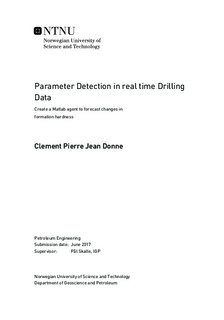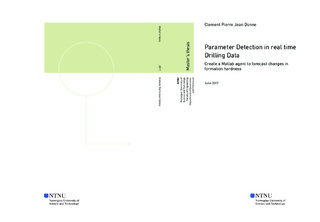| dc.description.abstract | Nowadays, being cost efficient is a major issue of the oil and gas sector. Reducing Non Productive Time (NPT) is one of the solutions to tackle this challenge. As a result, the industry is always looking for more solutions to prevent failures and to reduce the number of incidents in order to increase the operational time.
The hardness of a formation is mainly linked to its mineral composition and its degree of cementing, but unexpected changes in formation hardness can create an inefficient rate of penetration (ROP), a too high torque on the drill string, a too high weight on bit (WOB), and a fast drilling bit wear. These phenomena can create severe failures such as drill pipe failures, stuck pipe or washout, and local doglegs.
The objective of this master thesis is to provide a data agent in Matlab able to forecast these changes in formation hardness using real time drilling data (RTDD) and to subsequently provide a hardness classification of the complete well path.
Regarding the hardness computation, the mathematical model behind the algorithm of the program is a simple version of ROP model proposed by Bourgoyne and Young in 1986. The forecast is an autoregressive moving average (ARMA) model. Several further assumptions are made to finally compute and forecast formation hardness through drillability using ROP, WOP and revolution per minute (RPM), all available in real time drilling data. According to previous studies made on the same Bourgoyne and Young model, relevant exponents are selected for WOB and RPM depending on the formation being drilled. ARMA coefficients are selected using an iterative process within the agent algorithm.
To notice the efficiency of the agent proposed, a comparison is made between hardness classification results given by the program and changes in formation hardness looking through RTDD of ten wells and their geological reports. Information on how to select relevant real RTDD cases, how to clean raw files, and how to process them is also provided.
Finally, the agent provides hardness classification reports and forecast while drilling but the precision and the accuracy is quite low. These irregularities are mainly due to the assumption made in the mathematical model used for hardness computation and in the forecasting model. Imprecision in test cases implementation is another factor of the final low accuracy of the agent. | |

